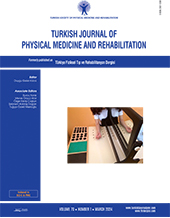Investigation of incidental findings of temporomandibular joint disorders on brain magnetic resonance imaging in three-dimensional T2-weighted SPACE sequence performed for brain imaging
2 Department of Radiology, Medicine Faculty of Düzce University, Düzce, Türkiye
3 Departmant of Family Medicine, Medicine Faculty of Düzce University, Düzce, Türkiye DOI : 10.5606/tftrd.2024.12538 Objectives: The study aimed to determine the temporomandibular joint (TMJ) findings, to investigate the prevalence contribution of this sequence on cases in which cranial magnetic resonance examination was performed and three-dimensional (3D) T2-SPACE (T2-weighted sampling perfection with application-optimized contrasts using different flip-angle evolutions) sequence was used by retrospectively scanning the magnetic resonance imaging (MRI) archive of our hospital, and to reveal the advantages of the 3D-T2 SPACE sequence in patients with TMJ disorders.
Patients and methods: The cross-sectional retrospective study was conducted with 499 patients (289 females, 210 males; mean age: 50.1±17.7 years; range, 8 to 92 years) who underwent brain MRI and had 3D-T2 SPACE between March 1, 2021 and March 1, 2022. Two radiologists analyzed the TMJs of the subjects included in the study in 3D-T2 SPACE sequences.
Results: At least one incidental finding was detected in the TMJ in 37.1% (n=185) of the patients included in our study. In our study, the most common (13.6%) MRI findings were osteoarthritic changes and synovial cysts. Joint effusion (13.2%) and disc displacement (9%) were less frequent. When the relationship between the age of the patients and the presence of incidental findings, degeneration, effusion, disc displacement, and cyst was examined, the age of the patients with incidental findings (p=0.001) and osteoarthritic changes (p<0.001) was statistically significantly higher.
Conclusion: Incidental findings, particularly osteoarthritic changes and synovial cysts, can be seen quite commonly in the TMJ in brain MRI using 3D T2-SPACE sequences in the general population. The 3D T2-SPACE sequence provides valuable information in the recognition of TMJ disorders.
Keywords : 3D T2-SPACE, incidental findings, temporomandibular joint
















